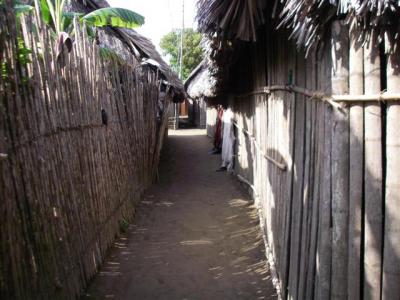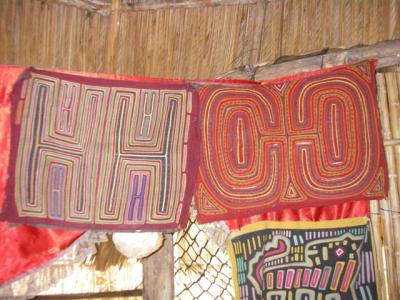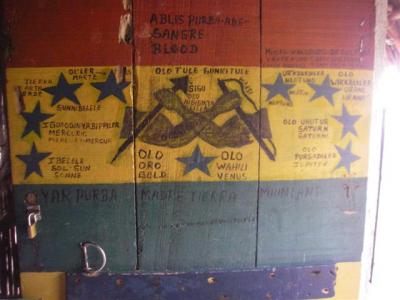Today was the busiest day we have had in a while. Since we went to bed early, we were up early, too. We peered outside. No cruise ship. We made breakfast and again peered outside. This time we saw the cruise ship in the distance, approaching us. We decided to get to shore ASAP. We knew it would take the cruise ship a while to bring down their tenders and shuttle the tourists to shore, so maybe we could get in and out before too many tourists flooded the islands.
We quickly got the dinghy down and headed out to the closest island, Carti Suitupo. Carti Suitupo is the closest to the mainland of all the islands, and thus the most densely populated. We went there first because it is the island with the museum. We saw a dock just around the corner from Kosmos’ line of sight, a small wooden dinghy dock. We watched a motorized dugout canoe with two tourists pull up to the dock. We pulled in on the other side of the dock and waited until a local wandered by, then asked if we could leave our dinghy there. He said no problem.
From the dock there was a narrow dirt walking path that led between tightly packed huts. Most of the huts had bamboo walls and a roof made of thick layers of palm fronds. A few of the huts had a slanted metal roof similar to what we saw around the rest of the Caribbean. We did see a couple of buildings made of concrete. Some of the huts were almost touching. All the yards were surrounded by bamboo fences. The edges of the houses and the fence were literally on the edge of the walkway. With the housing so tight, in a way, it reminds us of Medieval European cities, except in Europe the buildings aren’t made of bamboo and palm fronds.

There were a lot of people walking around, many carrying big quantities of assorted food products. Several times we had to press our bodies up against a hut to make room for someone with an arm load of produce to pass us. Most of the women were in the traditional Kuna outfits, but a few were wearing western attire. The ones in western attire were usually teenagers or young adults. There were a surprising number of children running around. We said hi to just about everybody we passed, but few responded. This island sees so many tourists that tourists clearly don’t interest them much anymore. No one approached us to buy molas.
As we were wandering along, John, the local who had helped us anchor, walked by. He was carrying a large sack of potatoes and invited us to his house. We followed him through a maze of little pathways and came to probably the biggest house we had seen yet. It was two stories and probably quadruple the size of the other huts. The construction was different than we had seen yet. There was a concrete frame, with concrete block to about knee high and concrete pillars all the way to the roof line. In between the pillars there are bamboo walls. Inside the floor is dirt. Near the front door is a table and chairs, and several woman sitting at the table. Along the walls were some small shelving units holding some small assorted goods. There were a few pictures hanging from the concrete pillars. A couple hammocks were strung from the ceiling, and a teenage boy on a cell phone was in one of them.
John dropped off the potatoes and told us we needed to get to the museum before it closed. We thought his English was off. After all, it was about 0830. He probably meant get there when it opens. We followed him down another path and into a building that turned out to be the town hall and he introduced us to several men who happened to be in there. We suspect they are high up members in the community. We headed back out and continued on the same path. We noticed a few soldiers in camouflage uniforms and were confused. We thought the Panamanians stayed out of the Comarca. Why would they send soldiers here? We then noticed a local wearing a gun strapped around his torso. John stopped to talk to him and then the armed man started to walk with us. A minute later the man with the gun explained that tomorrow they are celebrating the biggest holiday of the year, when they won their autonomy from the Panamanians. As part of the festivities tomorrow, there was going to be a re-enactment of the revolution, and he was part of the cast. He had just come from the dress rehearsal. Ah, that explains the soldiers, too.
The armed man smelled strongly of alcohol. He mentioned that last night there was a huge celebration in the town and everyone was drinking all night. When asked if it was tied to the upcoming holiday, they said no, it was something separate altogether.
We turned a corner and wandered down another small lane to the museum. It is inside one of the small traditional huts. All the walls were loaded with assorted goods on display. Most of the items had hand written signs describing the object(s). Some were in English, some in Spanish. It turned out our new actor friend is the museum owner and curator, Jose. He pulled up 4 plastic chairs into the center of the room. The three of us sat down. Jose went around the room and explained in broken English what all the different displays represented. He is passionate about the culture and the people and was enthusiastic about this presentation.
He started with the history. Most of the information we already knew. Jose told us again and again how much the Kuna love and welcome Americans. He said they will never forget the help the Americans gave to the Kuna. Then he went on to explain some aspects of the culture, which we especially enjoyed. Several of their customs are to provide protection, including the molas and the gold nose rings that the women wear. Traditional molas have repeating geometric patterns which represent patterns seen in nature (shown below). The molas with the animal designs are to sell to tourists and generally not worn by the Kuna. The gold nose ring is believed to repel evil spirits.

This picture is of Nunki dolls, which represent your spirit. Every Kuna has at least one, and usually several. They are the Kuna’s most treasured possession. The Kuna believe that physical sickness is caused by evil spirits and the dolls protect you from getting sick. The Kuna take the dolls with them to the doctor and the doctor looks at the doll to figure out what is wrong with the patient.

They also have Therapeutic Idols on display, which almost look like a walking stick with a Nunki Doll carved into the head. Apparently, there are special ceremonies to heal the sick in which the Therapeutic Idol is waved around to ward off the evil spirits. Each stick has a different image, so maybe each stick wards off a different spirit. There is also a display on traditional medicines they use in addition to the Therapeutic Idols. There are several baskets filled with plants that are believed to have healing power. Tobacco is one of the medicines and is smoked in the room with the sick person during the ceremonies.
Jose blew a conch shell for us, which is believed to scare away the bad weather.
They have their own ancient written language, which uses hieroglyphic symbols surprisingly similar to ancient Egyptian hieroglyphs. The chart he showed us had 291 characters. We are not sure if that was an exhaustive list or if it was just a sampling of their symbols, and also not sure if each symbol represents a separate individual words, line in Chinese, or if the symbols are put together to make words. We get the impression that today they use the Spanish alphabet to write words instead of the hieroglyphics.
Something that surprised us was that the swastika has been a sacred Kuna symbol for hundreds of years, which means life and good luck to them. It is interesting that they have the same symbol with the same meaning as the ancient Buddhist and Hindus. The Kuna used to put swastikas on their ankles, though he didn’t say how. We wonder if it was an anklet or a tattoo or some other method.
Jose moved on to astronomy, which was a complex lecture. Like all the other ancient peoples we have studied in our travels, the stars and planets are believed to represent specific gods and how the stars and planets move represents interaction between the gods in the celestial realm.
He went on to explain the symbolism of the Comarca flag. It has three horizontal stripes, the top red, the middle gold and the bottom green. The red symbolizes the blood spilled to preserve the Kuna nation. The gold in the middle reflects away evil spirits. The green represents the land. In the gold section there is a picture of two muscular male arms crossed, like a man crossing his arms across his chest so the right hand touches the left shoulder, and left hand to right, but you can’t see the torso, just the arms. One hand holds a bow, the other an arrow. This symbolizes brotherhood and coming together to fight the enemy with weapons. Around the arms are 9 five pointed stars, representing the sun and the planets. Here is a photo of the display explaining the flag.

There were some displays that Jose glossed over and didn’t spend much time explaining. One was a display small of what they hunt on the mainland, including deer, rabbit and jaguar. There was a small display of musical instruments, including maracas and panflutes made of bamboo. Another display showed the things that are buried with the Kuna. There was a board with pictures of the chiefs of each of the islands. All of the chiefs are old guys wearing derby hats. The network of chiefs make up the local government. Three of the chiefs represent the Comarca in the Panamanian government. There was also a small display on puberty ceremonies and the making of chichi beer for the ceremony. The only thing he said about it is that chichi beer is a sacred drink only used on holidays and special occasions. We had no idea how much more we’d learn about the sacred puberty ceremony and chichi beer later in the day.
Here is a photo of Christi wearing what we believe is a chief’s hat, but we aren’t sure.

To be continued”¦

Christy looks stunning as ever in her feather hat!
-rich